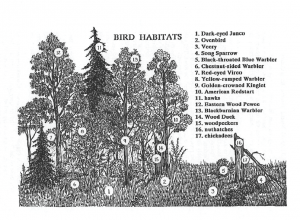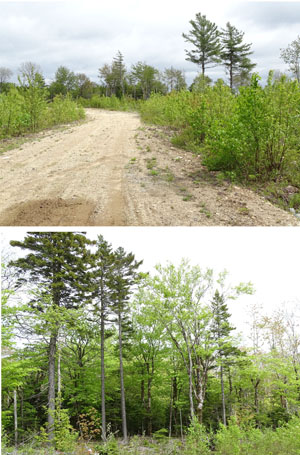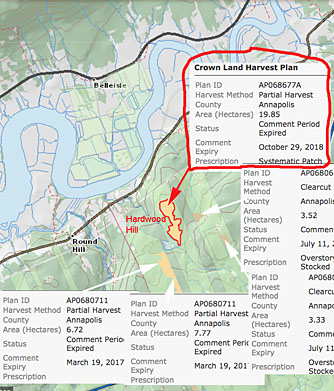A letter from an Annapolis Co. resident appealing to the Premier and others to reject or greatly modify proposed Crown land tree harvests on Hardwood Hill has been circulating in social media.
It is as eloquent a statement of how Nova Scotians value our landscapes, and our forests in particular, as I have read anywhere.
It is reproduced below.
Thanks, R.F.
————————-
Honourable Premier McNeil
Office of the Premier
7th Floor, One Government Place
1700 Granville Street
Halifax, NS B3J 1X5
Honourable Premier McNeil
Constituency Office
142 Commercial Street
PO Box 1420
Middleton NS BOS 1P0
Honourable Timothy Habinski
Warden for the County of Annapolis
752 St. George Street
PO Box 100
Annapolis Royal NS BOS 1A0
Honourable Iain Rankin
Minister of Natural Resources
Departent of Lands and Forestry
Founders Square
1701 Hollis Street
PO Box 698
Halifax, NS B3J 2T9
Julie Towers
Deputy Minister, Lands and Forestry
Founders Square
3rd Floor
1701 Hollis Street
NS B3J 2MS
November 7, 2018
To whom it may concern:
The proposed harvest of plot AP0668677-A is a matter of concern to members of the local Tupperville Community (as well as to residence in the surrounding area who use or have used this area), many of whom know the area as Hardwood Hill. We are concerned with impacts to biodiversity including wildlife, and to ecosystem services.
The forest area proposed for harvest encompasses a mixture of mature to old growth Eastern Hemlock and immature, spindly American beach (mostly between 30 to 40 years old and not get ready for any kind of harvest) and small amounts of red spruce in the northern portion of the plot. Tree species gradually shift to white pine, red spruce and other species where the plot narrows and becoming eastern hemlock/mixed species again as the plot widens toward the south. In the northern portions of the proposed harvest plot, these observations do not match with the species composition indicated in the Nova Scotia forest inventory shapefile available through the Nova Scotia open data portal (https://data.novascotia.ca/Lands-Forests-andWildlife/Forest-Inventory/c8ai-fjby) which describes a stand of predominately red spruce, with varying amounts of sugar maple, balsam fir, and red maples, with no mention of eastern hemlock or American beach within this southernmost portion of the proposed harvest plot. In any case the stand is maturing and mainly represented by late successful species that are relatively rare near the valley floor.
This stand falls within the “valley slope” ecodistrict according to the Forest Ecosystem Classification. This narrow ecodistrict has an under-representation of old growth. We ask that you consider the stand which, despite many human disturbance through the years, features the characteristic shade tolerant species that should naturally be found here. It is in close proximity to the Annapolis Valley which is largely devoid of forests, and this increases its significance to local residents, especially given the fact that over the last 10 years or so a large amount of forest has been cut in the valley slope ecodistrict and upslope from here, mostly by clearcutting, leaving an ever shrinking amount of mature forest in general.
Local residents have utilized this section of forest for generations and continue to utilize it in various ways: mainly for hunting and wild game that take shelter under the closed canopy of hemlocks and red spruce, and for mushroom gathering in the mature to hold growth forests. Other simply enjoy the serene calm this place provides. Even those residents who do not venture into the forest itself benefit from the ecosystem services this forest provides by slowing and filtering rainwater, purifying the air as well as their drinking water and providing the rural aesthetics that led many residents to choose to live in the area. They do not want forest practices that couldn’t tail herbicide use. Some residents have been concerned about the recent cuts behind their homes which have caused increased water movement and flooding of basements and culverts that are down hill from the cuts. For others there is deep attachment to the forest and some residents are actively engaged in promoting more holistic forest management practises.

Graphic (inserted) from Blomidon Naturalists Society – view Natural History of forested lands in Kings Co., Nova Scotia
There is a great deal of biodiversity and wildlife habitat found in this section of forest. The combination of American beach with eastern hemlock leads to excellent food and shelter services in the form of beechnuts and cavity trees what supports a wide range of species including barred owls, flying squirrels, porcupine, and black bears. The American marten (an endangered species in Nova Scotia) has been known to be in the area and we have photos of fisher passing through this plot. Were any of these wildlife noted in the original forest assessment? Vernal pools cast in the perpetual twilight of closed-canopy, mature to old growth eastern hemlock-sugar maple-red spruce, along with the more seasonal light of younger spindly American beach abound due to the hummocky nature of the landscape, providing another layer of habitat diversity able to be utilized by a wide range of amphibians and other species. Owls have been observed hunting squirrels, being able to dart through the Eastern hemlock trees due to the wide spacing that is formed between the mature trucks. A wide range of fungi can be found throughout the forest, creating a vast mycelium network on the ground and forming a variety of mushrooms above ground with at least 16 species observed.
Even though the proposed plot is slated for a partial harvest, specifically a systematic patch cut, many residents feel that this would be still be too much removal and disruption, given the fact that many of the trees are either very young, or old/almost old growth. The anticipated increase in large vehicle traffic (particularly logging trucks) on this narrow winding stretch of the 201 and necessary road upgrades to the Langille Road (right now the overgrown rutted remnants of what was once a road) to be able to get this large equipment up to the site are also cause for concern amongst many local residents. All of these factors from the cut itself, to potential herbicide use on the site, to the access road up to the site have residents who are mostly on residential wells concerned for the quality of their drinking water.
Cutting this plot is counterproductive from ecological and cultural standpoint but it is also very likely counterproductive from an economic perspective. Many trees in the stand are too crooked to be used for lumber and so would likely end up woodchips which fetch a very low price on the market, and only provide value once while reducing or eliminating other more perennial values (such as wildlife habitat, hunting, edible mushrooms, ecosystem services etc.)
The undersigned people do not approve of harvesting for wood chips and request information on what the products their public forest will be used for and where they will go. Furthermore, is there an intention to return to this forest after a relatively short period of time perhaps only several years to harvest the remaining forest? What kind(s) of follow-up treatments would be planned? We would like to learn more of the plans to what follows an initial patch cut. Would there be more patch cutting on the remaining forest affectively removing nearly all of the forest once the road is in place?
Looking at some of the values that might be lost, if one assumes venison to be worth $10 per pound (comparable to organic beef) then an average (based on estimates of local residents) this forest produces the equivalent of approximately 150 pounds of dressed venison per year or or $1500 worth every year or $75,000 over a 50 year period just from deer meat alone, exploding the value of hunting licenses sold, equipment purchased (ammunition, guns, clothing) associated with hunting. Other animals such as bear grouse and snowshoe hare, are also hunted in this forest with licenses and equipment associated with them. This forest generates a feeling of self-sufficiency among some residents that comes from supplying at least some of their food. These are simply some of the values based around hunting and does not even scratch the surface of the other values as far as provides.
If any timber cutting operations were to be considered they would have to be small in scale and very light and impact to match the very small amount of high-value timber available on the site. The hemlock, red spruce, beach and sugar maple all require very small openings to regenerate and grow straight to produce future saw logs. Harvesting individual trees rather than whole clusters of trees is more suited to the stand, with no use of herbicides. and reducing the area slated for harvest significantly to more accurately reflect the reality on the ground.
In short, the most logical action here ecologically, culturally, and economically is not to perform a systematic patch cut on this forest system which, even with the possible eventual influence of hemlock woolly adelgid, will continue to provide an enormous and likely increasing amount of value to local people and wildlife for years to come if not compromised by cutting.
Thank you very much for your time.
Sincerely,
Randy Fredericks
————-
Comment on Eastern Shore Forest Watch Association Facebook page, Nov 11, 2018: “Not only eloquent. Also informed by deep knowledge of forest ecosystem and community values — tree species, non-forestry values of the forest, biodiversity, ecosystem services, community concerns, impact of forestry roads, future plans for the forest … This brilliant letter details many of the concerns that the Government SHOULD explore before it allows cutting on Crown land – land which it manages on behalf of THE PEOPLE OF NOVA SCOTIA. That’s us. This letter should carry weight because it expresses the views of citizens about their/ our land.”
—————————————-

Above: A lot of Annapolis Co. looked like this in late May, 2017.
Below: Still to be harvested (or possibly left): a few remnants of the old, mixed Acadian forest that had occupied the area before the clearcut.
I have some feeling for this area. My great grandfather was the last resident of of Roxbury, the forestry town south of Paradise, Anna. Co., and my Mom was from Lawrencetown. In the 1970s I worked with a farmer who had land on the Bellise marsh across the way. He was told that reversing the direction of water movement at the tidal barrage in Annapolis (so they could generate power) would not affect his farmland or anything else along the river. A few years earlier his whole farm had been inadvertently aerial sprayed by what we later came to know as Agent Orange and was told that the reason his cattle had abortions shortly afterward was bad hay, i.e., they blamed it on him; one son died of lymphoma a few years later. It seems government – even with one of their own in the premier’s office – is still doing adverse things to residents of the area and listening only after the fact and only when a lot of public fuss is made or lawyers get involved.

